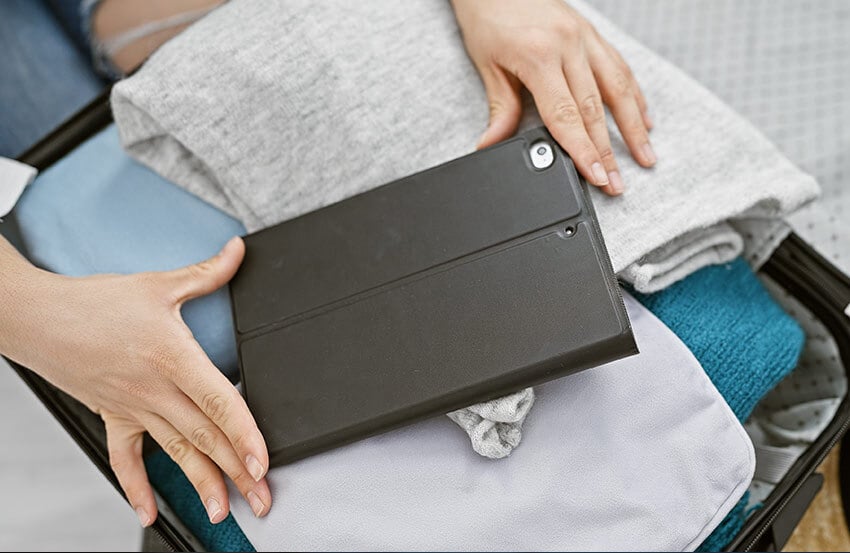Airport security can be strict about what you can bring on board. So, it's important to know the rules to avoid having to part with any of your devices.
Don't worry, though - we've got you covered. Ready to get up to speed on what electronics you can take through security and use on the plane? Let's dive in!

What electronics am I allowed to carry in my hand luggage?
The electronics you're allowed to carry in your hand luggage can vary from airline to airline.
Generally, the following are allowed:
-
Mobile phones
-
Laptops
-
Tablets
-
MP3 players
-
Hairdryer/hair straighteners
-
Travel irons
-
Electric shavers
-
E-cigarettes (although you won't be allowed to use it during your flight)
-
Some cameras (but there might be restrictions on professional equipment)
But, this list isn't definitive. So, make sure you check your airline's specific restrictions before you fly.
Do my electronics need to be charged?
Yes, you'll need to make sure that your devices are charged.
Why? Well, uncharged devices can be a potential security risk. It's important to have them fully charged so you can power them on if security asks. Just a heads up - if your devices aren't charged, they could be confiscated!
Taking electronics through airport security
Plenty of us are familiar with the hustle and bustle of going through airport security!
It's a smart idea to make sure your devices are placed at the top of your carry-on. That way, if you need to take any of them out, you'll have easy access to them.
You might need to remove laptops, phones and tablets from your carry-on before going through security, too. This is because they'll need separate screening. Security will let you know whether you need to take them out of your bag or not. Having them ready ahead of time can help you avoid hold-ups and get through security more smoothly.
Can I use electronics on a flight?
Yes, you're usually able to use electronic devices during a flight. This includes things like phones, tablets and laptops.
But, there's usually some restrictions. For example, making sure they're switched off for take-off and landing. This is just to avoid interfering with the aircraft's systems.
Helpful hint: Unsure about what you can use and when you can use them? Just ask the cabin crew - they'll be happy to help.
Can I use Bluetooth devices on a flight?
Usually, yes.
This means you can enjoy your pre-downloaded music or movies on your chosen device. Plus, if you want, you can ditch your wired headphones and use Bluetooth headphones to listen to them instead.
Just remember, you might be asked to remove Bluetooth headphones when the plane is taking off and landing. Plus, don't forget to remove them during the emergency briefing at the start of the flight. Safety first!
What is airplane mode? Is it necessary?
If you're bringing electronics onto a flight, you'll need to switch them to 'airplane mode'.
This setting prevents your phone from using mobile data, WiFi and phone networks. Once airplane mode is on, you won't be able to connect to the internet or send and receive calls or messages.
The reason for this is to prevent devices from interfering with the plane's critical electronic systems. Any interference could impact the pilot's ability to use radar tools and communicate with ground control.
Top tip: Want to stay connected while in the sky? Some airlines offer in-flight WiFi that you can use while keeping your phone toggled to airplane mode. But, you usually have to pay for it.
Can I take batteries on a plane?
Yes, you can normally take batteries on planes.
But, there's a few restrictions to keep in mind. These rules can vary between airlines, so it's important to check your specific airline's guidance before your travel day.
In general, you need to put batteries in your carry-on bag. They're not allowed in checked luggage because they could be a fire hazard. There's also usually a wattage limit you'll need to follow, which can differ depending on the airline. So, it's a good idea to double-check with yours before you fly.
You can also bring phone chargers in your carry-on, including a battery-pack or power bank. But, the cabin crew might ask you to switch them off during take-off and landing.
Sometimes, you might need special permission to bring certain batteries onboard. If you're unsure, it's best to contact your airline ahead of time to clarify.
Are my electronics covered by my travel insurance?
Cover for gadgets and electronics on travel insurance can vary from insurer to insurer.
Some providers consider devices like phones and tablets to be personal items. So, this means they'll be covered under the 'theft, damage and accidental loss' section of your poliy, sometimes known as baggage cover.
But, for more expensive electronics, like laptops, you might need a gadget insurance add-on for extra cover, which comes at an extra cost. The same goes for any devices you plan to put in your checked luggage. Check your policy details to see if you'll need any additional coverage for the devices you plan to take with you.
What should I do if my electronic device is confiscated by airport security?
It depends on the airport you're at.
In most cases, you'll need to wait until you return from your trip to get back a confiscated device. But, some airports might offer the option of having it sent to a chosen address.
If your device was confiscated because it wasn't charged, some airports might let you charge it and then go through security. So, if you're not keen on leaving your device and want to wait, you could consider catching a later flight.
Our tips for travelling with gadgets
Travelling with electronic devices can be confusing. Follow our tips for a smoother travel experience:
1. Don't forgot to take out required devices from your hand luggage
Make sure that you don't forget to take electronics out of your carry-on, if needed. If you do, security might need to carry out extra security checks, and that could lead to length delays.
2. Check if you'll need adaptors
Bring any chargers you'll need for your devices. But, remember to check what adaptors you might need for the country you're travelling to.
Top tip: If you forget to bring an adaptor, airports usually carry them in the departures lounge.
3. Keep batteries and power banks in your carry-on
You can keep your power banks and batteries inside your carry-on. So, there's no need to worry about sticking them in the tray unless specifically instructed to by airline staff.
4. Double check network roaming charges
The last thing anyone wants is to be stuck with costly roaming charges.
Before you head abroad, check with your phone network to see what their roaming charges are. Depending on your plan, you might have access to unlimited or a set amount of data each day without extra roaming fees. If your plan doesn't cover this, your provider might offer data packages you can buy. Just make sure you're clear on what's included to avoid unexpected costs.
Psst! Did you know that if you buy travel insurance through us, you can get an eSIM with up to 2GB of roaming data?*
*eSIM comes with pre-funded credit and the amount of data received in exchange will vary based on the specific country you select. Compatible devices only. T&Cs apply.
5. Make sure gadgets are fully charged
Remember, make sure you've got your devices fully charged before you head to the airport! If any of your devices are flat, you might have to hand them over to airport security.
Compare travel insurance

